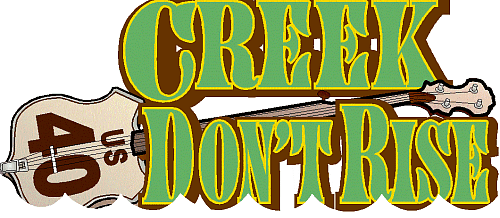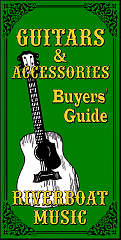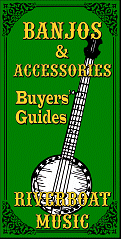



|


| Written by Paul Race for Creek Don't Rise? |
What is a Compensated Banjo Bridge?
Five-string players, have you noticed this?When you play an open G chord, it's perfectly in tune. Then you play a chord that requires playing the G (3rd) string at the second fret and the G string is distinctly sharp. Would it help you to know that this problem is as old as frets and steel strings on banjos?
Intonation on a fretted instrument includes the ability to play in tune no matter where the string is fretted along the neck. And all fretted instrument manufacturers know that when you fret a string, you're also stretching it a bit. So they place and angle the bridge to compensate for that stretching. In general, you'll notice that the distance between the 12th fret and the bridge is slightly more than the distance between the nut and the 12th fret. That's a deliberate attempt to compensate for the string being stretched.
But strings don't all react the same way to the stretching that occurs when you fret them. Some string thicknesses rise in pitch more than others.
On most acoustic guitars, you see the bridge sloped a little as a way of compensating for this difference. On most banjos that are set up correctly, the bridge also slopes a bit.
However, five-string banjos have their own issues. You may have noticed that when you fret the G (3rd) string at the second, third, or fourth fret, it is distinctly sharp, even if it's in tune when it's not fretted. This occurs on cheapies and high-end banjos both.
According to the folks at Deering, this wouldn't happen if you played with a "light" left hand, applying just enough pressure to fret the string, but not enough to push it all the way to the fretboard. I've tried it, and they're right. The only problem is that I also play 12-string guitar, and my left hand will never play "light." Furthermore, none of the other strings go that sharp when I fret them, and I guarantee I'm pushing them down just as hard as I do the G string.
There's something about the thickness of that particular string. That may have to do with the fact that - in most cases - it's relatively "fat" for a non-wound string. In fact many guitars with an unwound G string suffer a similar, but not so pronounced, affliction.
Over a century ago, when Zither banjos were being used to play arrangements similar to classical guitar, muscians complained that this issue made them sound out of tune even when they were doing everything "right." Some Zither banjo builders built them with staggered frets to compensate for this issue. But obviously, that posed challenges to the player's left hand. Shaping the bridge to compensate poses very few problems.
A "compensated" bridge has a very slight curve that lets the scale length of the G string be just a tad longer than that of the other strings. Most compensated bridges have other, slighter adjustments for the second and fourth string, but the G string is the one that really needs it.
 |
 |
If you need the best sound possible out of your banjo, and you buy a compensated bridge, you'll want to put some money into it, though I question whether you gain any advantage to speak of once you go much over $30.
Or if you just want to try a compensated bridge and see if it helps your intonation, you can get Asian-made compensated bridges for just a few dollars (though you have to wait until they get here, which might take a while it it's coming by container ship).
Whenever or wherever you order a compensated bridge, be sure to measure the height of your current bridge first. 5/8" is common, but some banjos have 1/2" bridges, and a few are even other heights.
And before you let anybody make you feel guilty about needing one, check out high-end banjos - many come with compensated bridges.
You can also buy compensated bridges for 6-string banjo, although they're harder to find. Again, some high-end six-string banjos come with compensated bridges, so it's not a sign of failure if you decide you need one. Compensated bridges for six-string banjos often have two curves, like a very shallow "S" curve. And they're a little harder to come by, since six string banjos aren't as common.
 Whatever else you get out of our pages, I hope you come away with some great ideas for "sharing the joy."
Whatever else you get out of our pages, I hope you come away with some great ideas for "sharing the joy."
And please stay in touch!
All material, illustrations, and content of this web site is copyrighted ? 2001, 2002, 2003, 2004, 2005, 2006,
2007, 2008, 2009, 2010, 2011, 2012, 2013, 2014, 2015, 2016, 2017 by Paul D. Race. All rights reserved.
Creek Dont' Rise(tm) is a participant in the Amazon Services LLC Associates Program, an affiliate advertising
program designed to provide a means for sites to earn advertising fees by advertising and linking to Amazon.com.
For questions, comments, suggestions, trouble reports, etc. about this page or this site, please contact us.
|
How To Help Us Promote Traditional Music for Free: If you find our tips, explanations, and recommendations helpful when picking out a product, and you appreciate that we don't continually inconvenience you with irrelevant ads or obnoxious popups, Please Bookmark This Page and come back through it when you're ready to order. In some cases - not all - we get a very small portion of your purchase price, all of which goes to supporting our sites. Ironically, if you don't come through our page, someone else like Facebook or the Weather Channel will usually get that "fee" anyway. In the meantime, it costs you nothing. We never see who placed the order, so you don't have to worry about us pestering you with followup e-mails or some such. But it helps us know what pages our readers find useful, and it helps our advertisers know who to support.
And that, in turn, helps us provide more useful resources. Thank you! |
| Visit related pages and affiliated sites: | |||||
| - Music - | |||||

|
 |
 |

|

|

|

|

|

|

|

|

|

|

|

|

|

|

|
| - Trains and Hobbies - | |||||
 |

|

|  |
 |

|
| - Christmas Memories and Collectibles - | |||||
 |

|
 |

|
 |

|
| - Family Activities and Crafts - | |||||
 |

|

|

|

|

|

